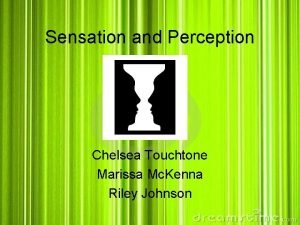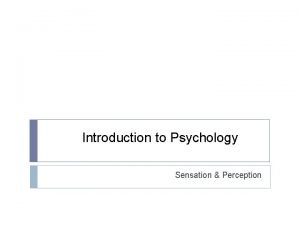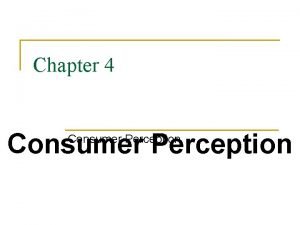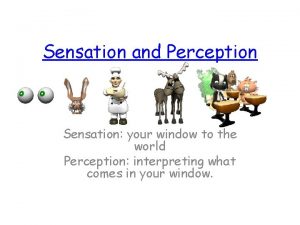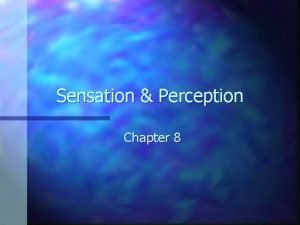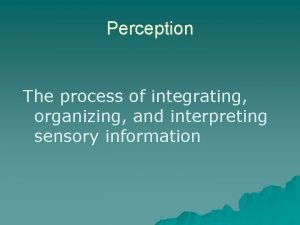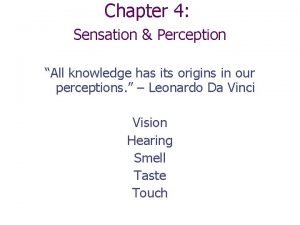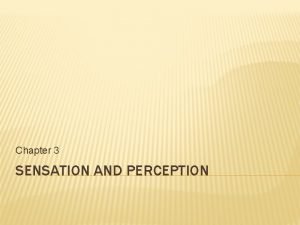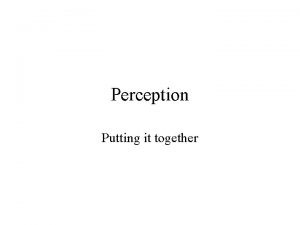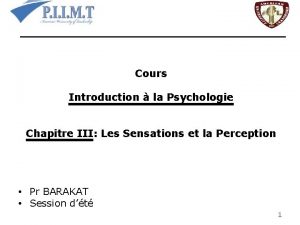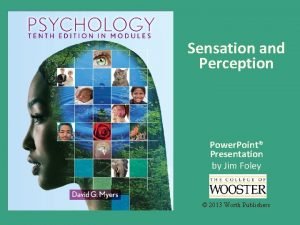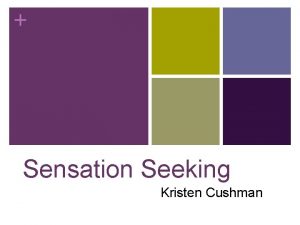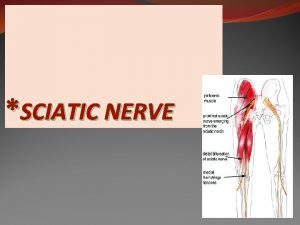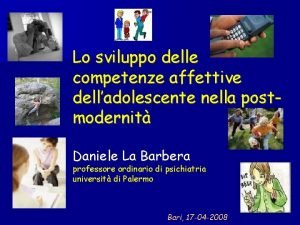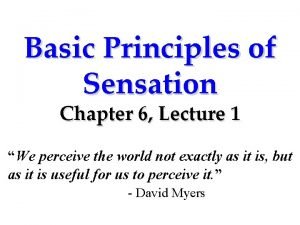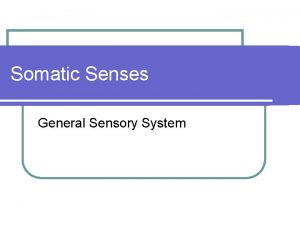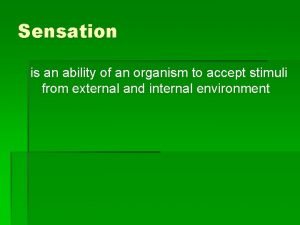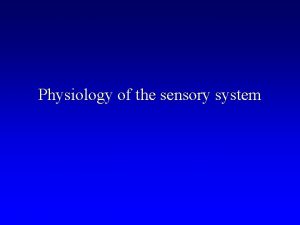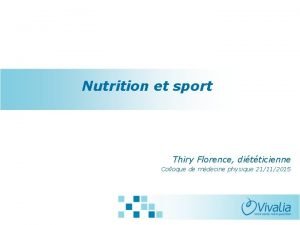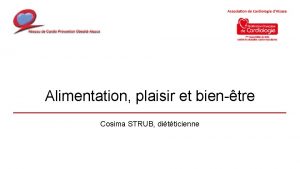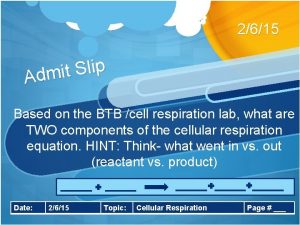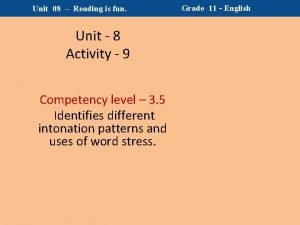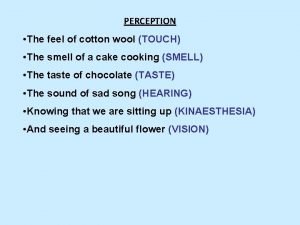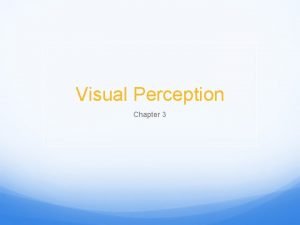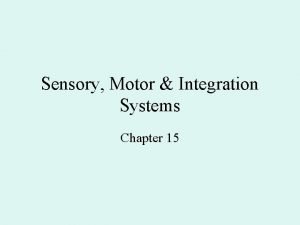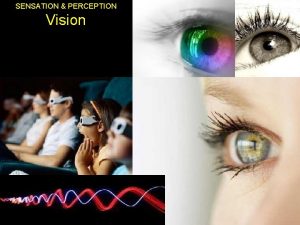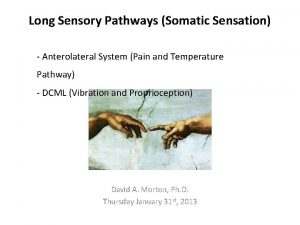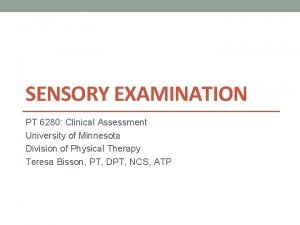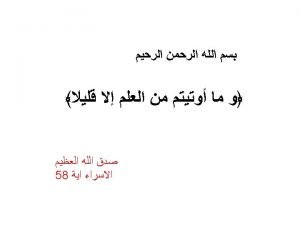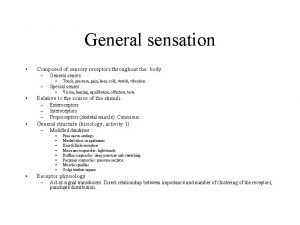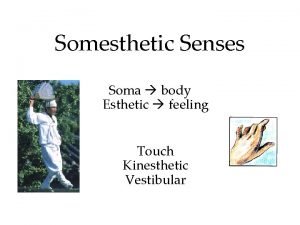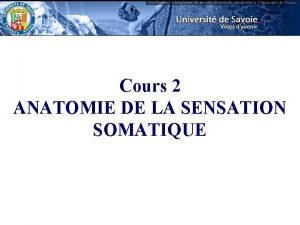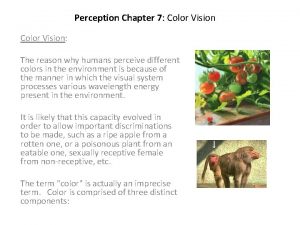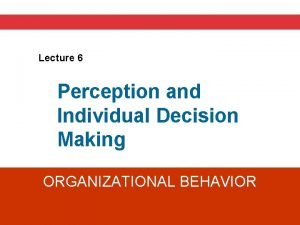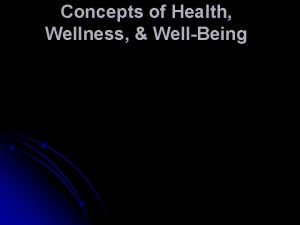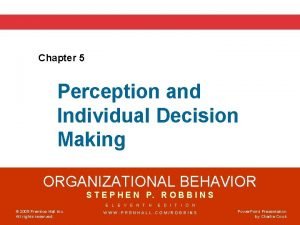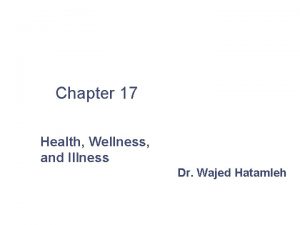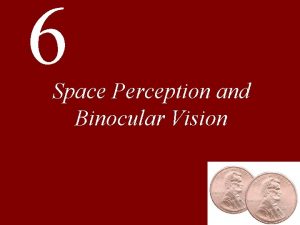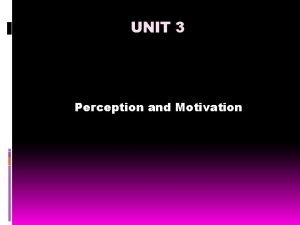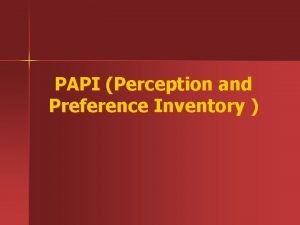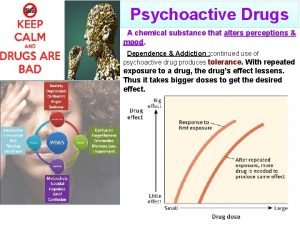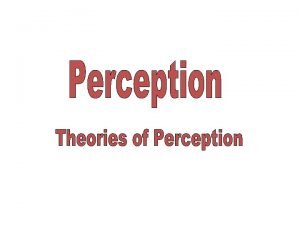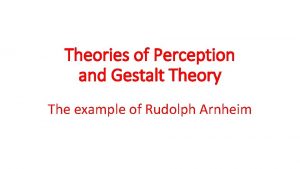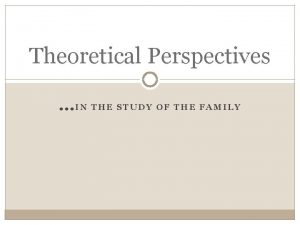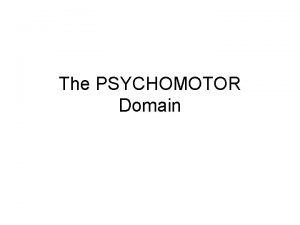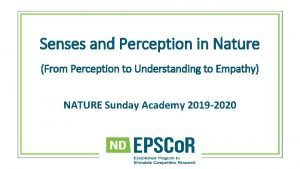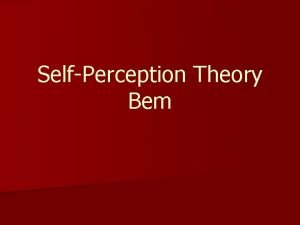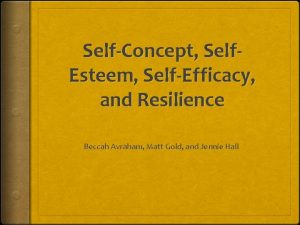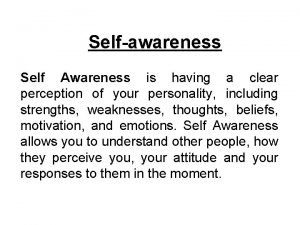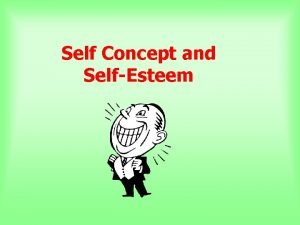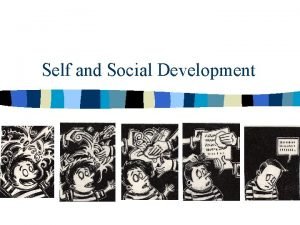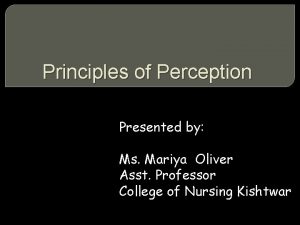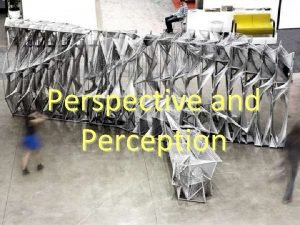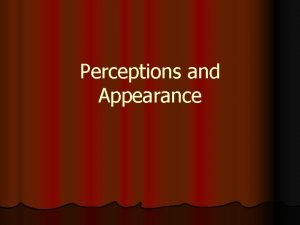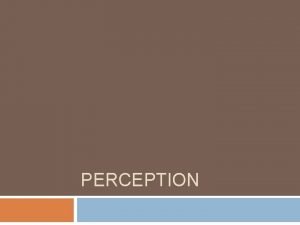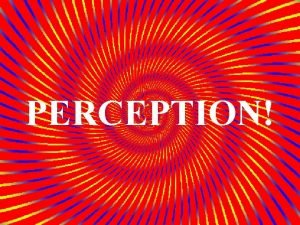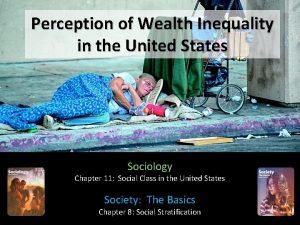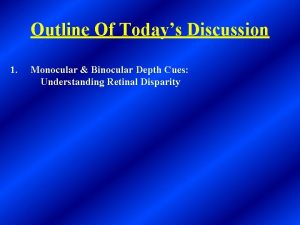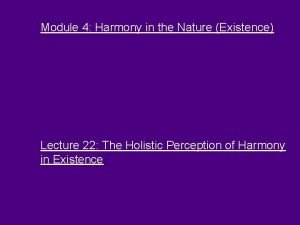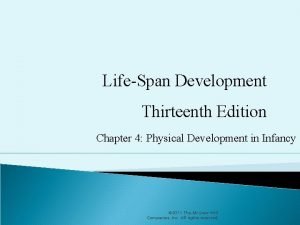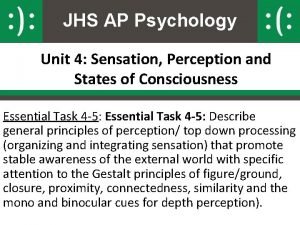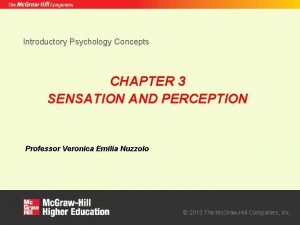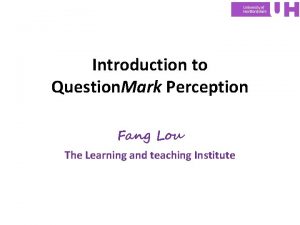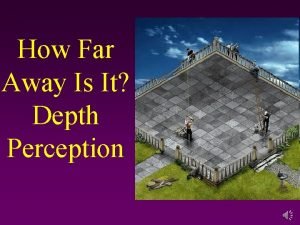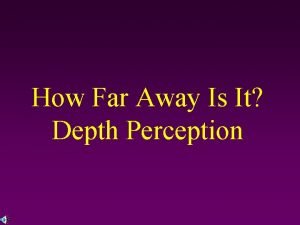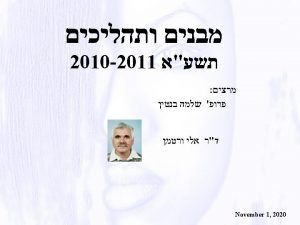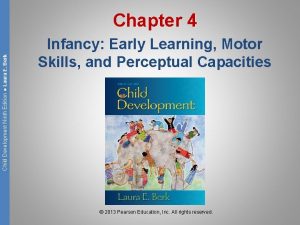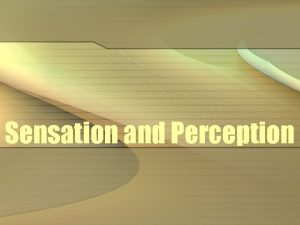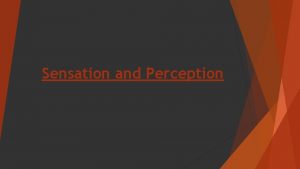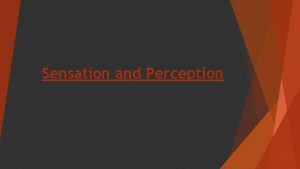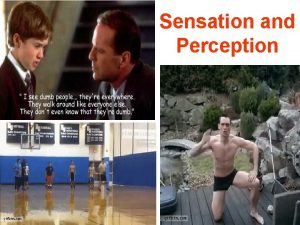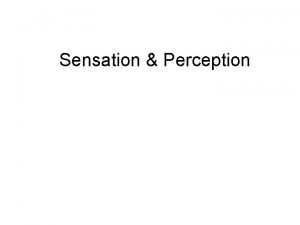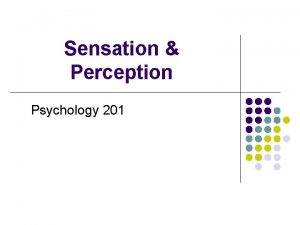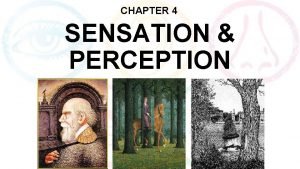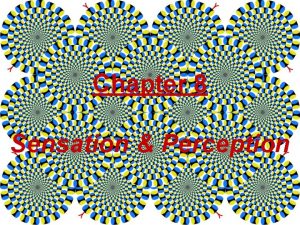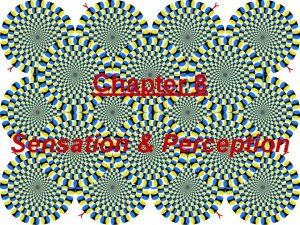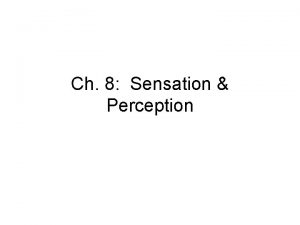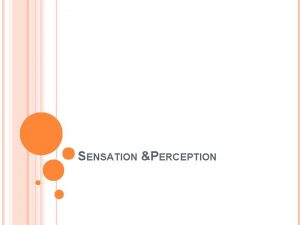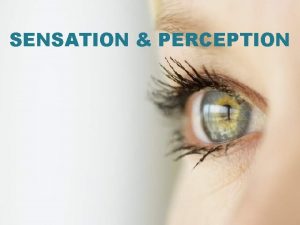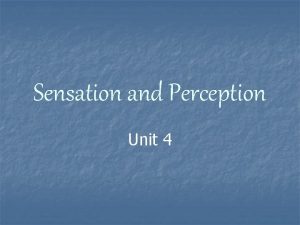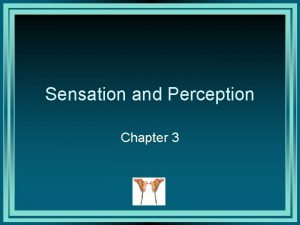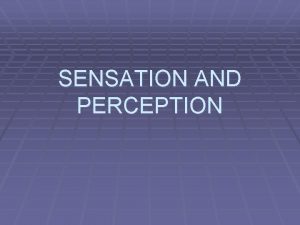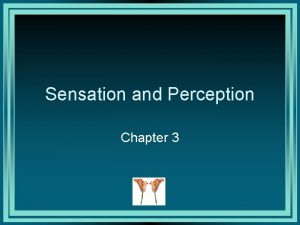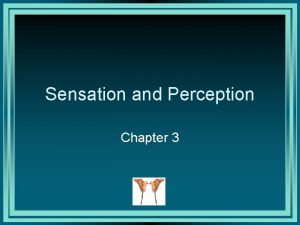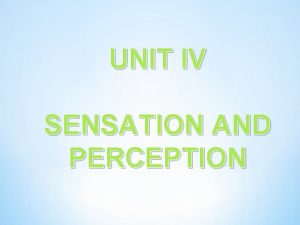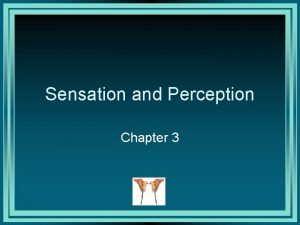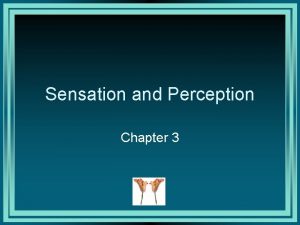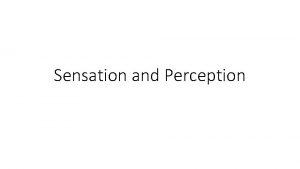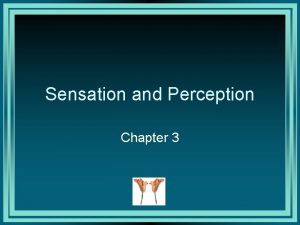Sensation and Perception 6 8 Sensation and Perception























































































- Slides: 87

Sensation and Perception 6 -8%

Sensation and Perception • Discussion starters

If you had to give up one of your senses, which would it be? If you could only keep one of your senses, which would you keep? Note the importance of the interaction between the senses!

How is sensation different from perception?

Sensation & Perception How do we construct our representations of the external world? To represent the world, we must detect physical energy (a stimulus) from the environment and convert it into neural signals. This is a process called sensation. When we select, organize, and interpret our sensations, the process is called perception.

SENSATION vs. PERCEPTION Sensation: Your sensory organs take in stimuli from the world Perception: How your brain interprets those stimuli based on our experiences, memories and expectations

Examples to show S&P difference ●“Our song” ●Pain ●New psych vocab ●Watching political debates ●Watching a football game

Bottom-Up Processing The brain pieces together all of the incoming stimuli to form a perception This relies heavily on SENSATION

Bottom-up Processing Analysis of the stimulus begins with the sense receptors and works up to the level of the brain and mind. Think of it as data-driven. Letter “A” is really a black blotch broken down into features by the brain that we perceive as an “A. ”

Top-Down Processing Perceptual processing that is based on higher level knowledge, expectation, memory Note: The Proofreader’s Illusion

Top-Down Processing Information processing guided by higher-level mental processes as we construct perceptions, drawing on our experience and expectations. Think of it as conceptually-driven THE CHT

Sensation and Perception Bottom up vs. top down? ●Wundt-Jastrow illusion ●Backmasking http: //jeffmilner. com/backmaski ng/

Sensation and Perception Bottom up vs. top down? The proofreader’s illusion Wundt-Jastrow illusion http: //www. michaelbach. de/o t/geom-Jastrow/index. html Backmasking http: //jeffmilner. com/backma sking/stairway-to-heavenbackwards. html

Top Down Processing Aoccdring to rscheearch at Cmbridge Uinvertisy. It deosn’t mttaer in what oredr the ltteers in a word are, the olny iprmoetnt tihng is that the frist and lsat ltteer be at the rghit pclae. The rset can be a total mses and you can still raed it wouthit a porbelm. This is bcusawe the huamn mnid deos not raed ervey lteter by istlef, but the word as a wlohe.

Likelihood Principle Herman von Helmholtz We will perceive the object that is most likely to be the cause of our sensory stimulation. That is, if a number of different objects could have caused a specific pattern of light and dark on the retina, we will perceive the object that is most likely to occur in that particular situation.

Perceptual Set (a. k. a. “perceptual expectancy”) Our expectations greatly influence our experience


Bottom-Up vs Top-Down Processing

Write what you see on a piece of scrap paper


What did that say?

Making Sense of Complexity Our sensory and perceptual processes work together to help us sort out complex images. “The Forest Has Eyes, ” Bev Doolittle

https: //youtu. be/IGQmdo. K_Zf. Y https: //youtu. be/x. AFf. YLR_IRY

Selective Attention The focusing of conscious awareness on a particular stimulus Cocktail Party Effect: ability to tend to only one voice of many Flow: so caught up in an experience that miss out on obvious stimuli

Selective Attention and Accidents

Selective Inattentional blindness: failing to see visible objects when our attention is directed elsewhere. Change Blindness: failing to notice changes in the environment. Change deafness Choice Blindness: when the object of their preference is switched with another one, do not acknowledge the difference and tend to find explanations for this altered choice. https: //www. youtube. com/watch? v=_VPcl 04 Adh 8 https: //youtu. be/FWSx. SQsspi. Q? list=PLC 0 A 3 CAC 7 B 3 A 0 E 288 https: //youtu. be/ub. NF 9 QNEQLA http: //www. simonslab. com/videos. html

http: //channel. nationalgeographic. com/braingames/videos/choice-blindness/ Choice Blindness http: //www. dailymotion. com/video/xq 1 p 3 e_nationalgeographic-test-your-brain-episode-1 -payattention_shortfilms

Sensing the World Senses are nature’s gift that suit an organism’s needs. A frog feeds on flying insects; a male silkworm moth is sensitive to female sex-attractant odor; and we as human beings are sensitive to sound frequencies that represent the range of the human voice.

Exploring the Senses What stimuli cross our threshold for conscious awareness? Transduction: Conversion of one form of energy into another…So in Sensation it’s the transforming of stimulus energies such as sights, sounds, and smells into neural impulses our brain can interpret.

Psychophysics A study of the relationship between physical characteristics of stimuli and our psychological experience with them. Physical World Psychological World Light Brightness Sound Volume Pressure Weight Sugar Sweet

Thresholds Proportion of “Yes” Responses 0. 00 0. 50 1. 00 Absolute Threshold: Minimum stimulation needed to detect a particular stimulus 50% of the time. 0 5 10 15 20 Stimulus Intensity (lumens) 25

ABSOLUTE THRESHOLDS Vision: a single candle flame from 30 miles on a dark, clear night. Hearing: The tick of a watch from 20 feet in total quiet. Smell: 1 drop of perfume in a 3 room apt. Taste: 1 tsp. sugar in two gallons of water. Touch: The wing of a bee on your cheek, dropped from 1 cm. Why is this even important? ?

Signal Detection Theory Predicts when we will detect new weak signals. Why do people respond differently to the same stimuli?

Subliminal Threshold: When stimuli are below one’s absolute threshold for conscious awareness. Priming: activation of certain associations-often unconsciously. http: //www. scentair. com/index. html

The difference threshold, also known as the just noticeable difference (JND) The minimum difference between 2 stimuli that one can detect 50% of the time

Difference Threshold/Just Noticeable Difference JND To function effectively we need absolute thresholds low enough to allow us to detect important sights, sounds, textures, tastes, and smells. BUT we also need to detect small differences among stimuli. Ex. Musician tuning an instrument; sound of your friends voice in a crowded hall The minimum difference a person can detect between any two stimuli half the time.

Weber’s Law the size of the JND tends to be a constant proportion to the initial stimulus The greater the original stimulus, the more you’d have to change it to notice a difference

Weber’s Law examples • Dating ages • Global warming • Backpack weight • Loud concert • Buying a house/other things

Weber’s Law Two stimuli must differ by a constant minimum percentage (rather than a constant amount), to be perceived as different. Difference thresholds grow with the magnitude of the stimulus. Proportion varies depending on stimulus: Light: 8% Weight: 2%

Sensory Adaptation Diminished sensitivity as a consequence of constant stimulation. Put a band aid on your arm and after awhile you don’t sense it. We perceive the world not exactly as it is, but as it is useful for us to perceive it.

Sensory Adaptation Your receptor cells become less responsive after prolonged exposure to a constant stimulus Ex: cold ocean, hot shower, loud concert, music in your car nasty smells Habituation Your brain stops paying attention to things that don’t change. However, as soon as that thing changes, it recaptures your attention Ex: billboards, signs in the school, noise, posters in the room, Home plate…

Sense Commonalities ● The Thalamus ● Receptor cells AND transduction

The specific receptors for each of the sensory systems

The Visual System: rods and cones in the retina responding to light waves

The Auditory Sense: hair cells in the cochlea responding to sound waves

The Olfactory Sense: olfactory cells in the nasal cavity responding to airborne chemicals

The Vestibular Sense: fluid and receptor cells in the semicircular canals in the inner ear responding to gravity and changes in position

Sense Commonalities ● The Thalamus ● Receptor cells AND transduction ● Interaction: Demo(s)

Sense Commonalities ● The Thalamus ● Receptor cells AND transduction ● Interaction ● Adaptation

Sensory Adaptation Your receptor cells become less responsive after prolonged exposure to a constant stimulus Ex: cold ocean, hot shower, loud concert, music in your car, nasty smells Habituation Your brain stops paying attention to things that don’t change. However, as soon as that thing changes, it recaptures your attention Ex: billboards, signs in the school, noise, posters in the room, Home plate…

Perceptual Adaptation -goggles and video

Sense Commonalities ● The Thalamus ● Receptor cells AND transduction ● Interaction ● Adaptation ● Thresholds

Absolute Threshold The minimum amount of a stimulus one can detect 50% of the time it is present

Absolute Thresholds (Galanter, ’ 62) Vision: candle flame on a clear night from 30 miles away Audition: tick of a watch at 20 feet Gustation: 1 teaspoon of sugar in 2 gallons of water Olfaction: 1 drop of perfume in a 3 room apartment Touch: bee’s wing on cheek from height of ½ inch

SUBLIMINALS The brain CAN receive information that “you” don’t perceive!

Subliminal messaging? ● Movies? Advertising? Music? ● “Eat Popcorn” ● LIPTON ICE experiment (23/1000 sec) ● Control 22% ● Experimental group = 85%

The Visual Sense

The Structure of the Eye


Rods & Cones Rods Cones 100 million per eye 5 million per eye black/white/gray color Dark adaptation Light adaptation edge of retina (periphery) center of retina (fovea)

The Retina’s Reaction to Light

Rods and Cones SUMMATIO N

Color Vision Radiolab: Color

Trichromatic Theory Three types of cones: • Red • Green • Blue • 7 million hues, maybe more?



The Mantis Shrimp (16 different types of cones!)

Color Afterimages

Afterimage Effect


Opponent Process Color Vision Theory: Humans are equipped with red/green cells and blue/yellow cells While one (for ex. , red) is “excited” the other (green for ex. ) is






Opponent-Process Theory


Opponent Process Color Vision Theory: Humans are equipped with red/green cells and blue/yellow cells While one (for ex. , red) is “excited” the other (green for ex. ) is

Feature Detector Cells ● Recall our spiral demo? That too was an opponent process demo ● Hubel and Wiesel (1981 Nobel Prize)

Color Blindness?

A “Color Blindness” Test

The Auditory System



Hair cells transduce the sound waves into electrical signals Those signals travel to the thalamus, then to the auditory cortex

GUSTATION ● a chemical sense ● cells regenerate every 7 -14 days ● supertasters vs. nontasters ● Sensory Interaction→ Smell + Taste + Texture = Flavor
 Chapter 5 sensation and perception
Chapter 5 sensation and perception Gestalt principles of visual perception
Gestalt principles of visual perception Perceptual set ap psych
Perceptual set ap psych What are sensations
What are sensations Sensation and perception crossword review answers
Sensation and perception crossword review answers Chapter 3 sensation and perception
Chapter 3 sensation and perception Sensation and perception
Sensation and perception Chapter 6 sensation and perception
Chapter 6 sensation and perception Psychology chapter 4 sensation and perception
Psychology chapter 4 sensation and perception Absolute threshold consumer behavior
Absolute threshold consumer behavior Webers law
Webers law Opponent process theory
Opponent process theory Kinesthesis and vestibular sense
Kinesthesis and vestibular sense Chapter 6 sensation and perception
Chapter 6 sensation and perception Sensation and perception uu
Sensation and perception uu Chapter 4 sensation and perception
Chapter 4 sensation and perception What is sensation
What is sensation Perceptual system
Perceptual system Cours sur la perception en psychologie
Cours sur la perception en psychologie Perception vs sensation
Perception vs sensation Old woman young woman illusion
Old woman young woman illusion Sensation seeking
Sensation seeking Sciatic nerve sensory distribution
Sciatic nerve sensory distribution Sensation seeking significato
Sensation seeking significato Principles of sensation
Principles of sensation Exteroceptors
Exteroceptors Sensation
Sensation Classification of sensation
Classification of sensation Back pain classification
Back pain classification Ditticienne base sur coute sensation
Ditticienne base sur coute sensation Ditticienne base sur coute sensation
Ditticienne base sur coute sensation What causes the burning sensation in your muscles
What causes the burning sensation in your muscles Reading 08
Reading 08 The touch the feel of cotton
The touch the feel of cotton Perception gestalt principles
Perception gestalt principles Sensation
Sensation Colour design: theories and applications
Colour design: theories and applications Dcml sensation
Dcml sensation What is the difference between sensing and intuition
What is the difference between sensing and intuition Cortical sensations
Cortical sensations Tactile localization meaning
Tactile localization meaning Somatic pain pathway
Somatic pain pathway Tectorial membrane
Tectorial membrane Vestibular sense vs kinesthesis
Vestibular sense vs kinesthesis Sensation somatique
Sensation somatique Chapter 7 vision and perception
Chapter 7 vision and perception Papi kostick interpretation
Papi kostick interpretation Perception and individual decision making
Perception and individual decision making Concepts of health and wellbeing
Concepts of health and wellbeing What they see
What they see Subjective perception of vitality and feeling well
Subjective perception of vitality and feeling well Binocular disparity
Binocular disparity Perception and motivation
Perception and motivation Perception and preference inventory
Perception and preference inventory Max martn
Max martn A chemical substance that alters perceptions and moods.
A chemical substance that alters perceptions and moods. Horizontal e vertical
Horizontal e vertical Gregorys constructivist theory
Gregorys constructivist theory Film als kunst
Film als kunst Perception vs perspective
Perception vs perspective Perception in psychomotor domain
Perception in psychomotor domain Subjective perception
Subjective perception Nature of perception
Nature of perception Over justification effect
Over justification effect Self image vs self perception
Self image vs self perception Self awareness is having a clear perception of
Self awareness is having a clear perception of Different self concept
Different self concept Self-concept
Self-concept Principle of context
Principle of context Perspective vs perception
Perspective vs perception Perception checks
Perception checks What does the word perception mean
What does the word perception mean What does this
What does this Selective perception
Selective perception Questions on perception
Questions on perception Perception of wealth
Perception of wealth The perception process
The perception process Crossed disparity
Crossed disparity Holistic perception of harmony
Holistic perception of harmony Rooting reflex
Rooting reflex Types of perception
Types of perception Perception meaning in psychology
Perception meaning in psychology Question mark perception
Question mark perception Texture gradient depth cue
Texture gradient depth cue Cues of depth perception
Cues of depth perception Categorical perception
Categorical perception Categorical perception psychology
Categorical perception psychology Intermodal perception
Intermodal perception




